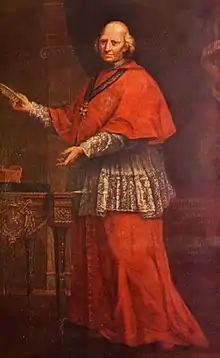Giuseppe Pozzobonelli
Giuseppe II Pozzobonelli (or Puteobonellus, 1696–1783) was an Italian Cardinal and the Archbishop of Milan from 1743 to 1783.
Giuseppe Pozzobonelli | |
|---|---|
| Cardinal, Archbishop of Milan | |
 | |
| Church | Catholic Church |
| See | Milan |
| Appointed | 15 July 1743 |
| Term ended | 27 April 1783 |
| Predecessor | Carlo Gaetano Stampa |
| Successor | Filippo Maria Visconti |
| Other posts | Cardinal Priest of San Lorenzo in Lucina |
| Orders | |
| Ordination | 23 Dec 1730 (Priest) |
| Consecration | 21 July 1743 (Bishop) by Pope Benedict XIV |
| Created cardinal | 9 September 1743 |
| Personal details | |
| Born | 11 August 1696 Milan |
| Died | 27 April 1783 (aged 86) Milan |
| Buried | Cathedral of Milan |
| Coat of arms |  |
Early life
Giuseppe Pozzobonelli was born on 11 August 1696 in Milan[1], which at the time was part of Duchy of Milan. Pozzobonelli was the son of a noble family, and lost his mother during childhood. He was educated by the Jesuits and on 5 January 1722 he earned a doctorate in utroque iure at the University of Pavia.[2]
On 23 December 1730 Giuseppe Pozzobonelli was ordained priest for the Archdiocese of Milan by Cardinal Benedetto Erba Odescalchi, who was his spiritual father. He joined the teaching staff of the seminary of his archdiocese. In 1734 he was named conservator of the Biblioteca Ambrosiana. Later he was named vicar of the archbishop for the nuns of the town.[3] At the death of Archbishop Carlo Gaetano Stampa on 23 December 1742 he was elected vicar capitular of the Archdiocese.[2]
Archbishop of Milan
In July 1743, Pope Benedict XIV named him archbishop of Milan, and on 21 July 1743 he was consecrated bishop by the pope himself in San Carlo al Corso, Rome. However he could formally take possession of Milan's diocese only eleven months later, on 21 June 1744, due to the late assent from Maria Theresa of Austria.[3]
In the meantime, on 9 September 1743, he was appointed Cardinal Priest with the title of Santa Maria in Via. He kept such title until 2 August 1758 when he moved to the title of Santa Maria sopra Minerva, and again on 28 May 1770 he moved to the title of San Lorenzo in Lucina.[1]
Giuseppe Pozzobonelli took very seriously his service as bishop: he made pastoral visits to almost all areas of his large diocese, he often preached and personally conferred the sacraments. He paid particular attention to the instruction and to the morality of the clergy. He celebrated a Jubilee in 1751 whose main event was the translation of the body of Saint Charles Borromeo among the streets of the town.[4] He supported the idea to place a statue of Virgin Mary atop Milan Cathedral (now known as the Madonnina), which was so erected in 1774 and became a reference point for the people of Milan.[4]
During his tenure as archbishop he kept good relations with the Habsburg authorities and he give his support to the former Jesuits after the Jesuit suppression. However starting from 1767 some contrasts arose with the Habsburgs due to some ecclesiastic reforms decided by the government.[4] Due to these rifts and to his poor health on 19 March 1769 Pozzobonelli tendered his resignation, but Pope Clement XIII refused to free him from his duties as archbishop of Milan.[3]
Pozzobonelli participated to the Conclave of 1758 and to the Papal conclave, 1769 where was believed to be a papabile. He didn't participated to the following conclave for health reasons.
Giuseppe Pozzobonelli died in Milan on 27 April 1783, and his remains were buried in the North nave of the Cathedral of Milan.
References
- David Cheney. "Giuseppe Cardinal Pozzobenelli". Catholic-Hierarchy.org. Retrieved 1 October 2012.
- Salvador Miranda. "Pozzobonelli, Giuseppe". Retrieved 1 October 2012.
- Cazzani, Eugenio (1996). Vescovi e arcivescovi di Milano. Milano: Massimo. pp. 253–257. ISBN 88-7030-891-X.(in Italian)
- Vismara Chiappa, Paola (1992). "Pozzobonelli, Giuseppe". Dizionario della Chiesa Ambrosiana. 5. Milano: NED. p. 2935–3541. ISBN 88-7023-102-X.(in Italian)
| Wikimedia Commons has media related to Giuseppe Pozzobonelli. |